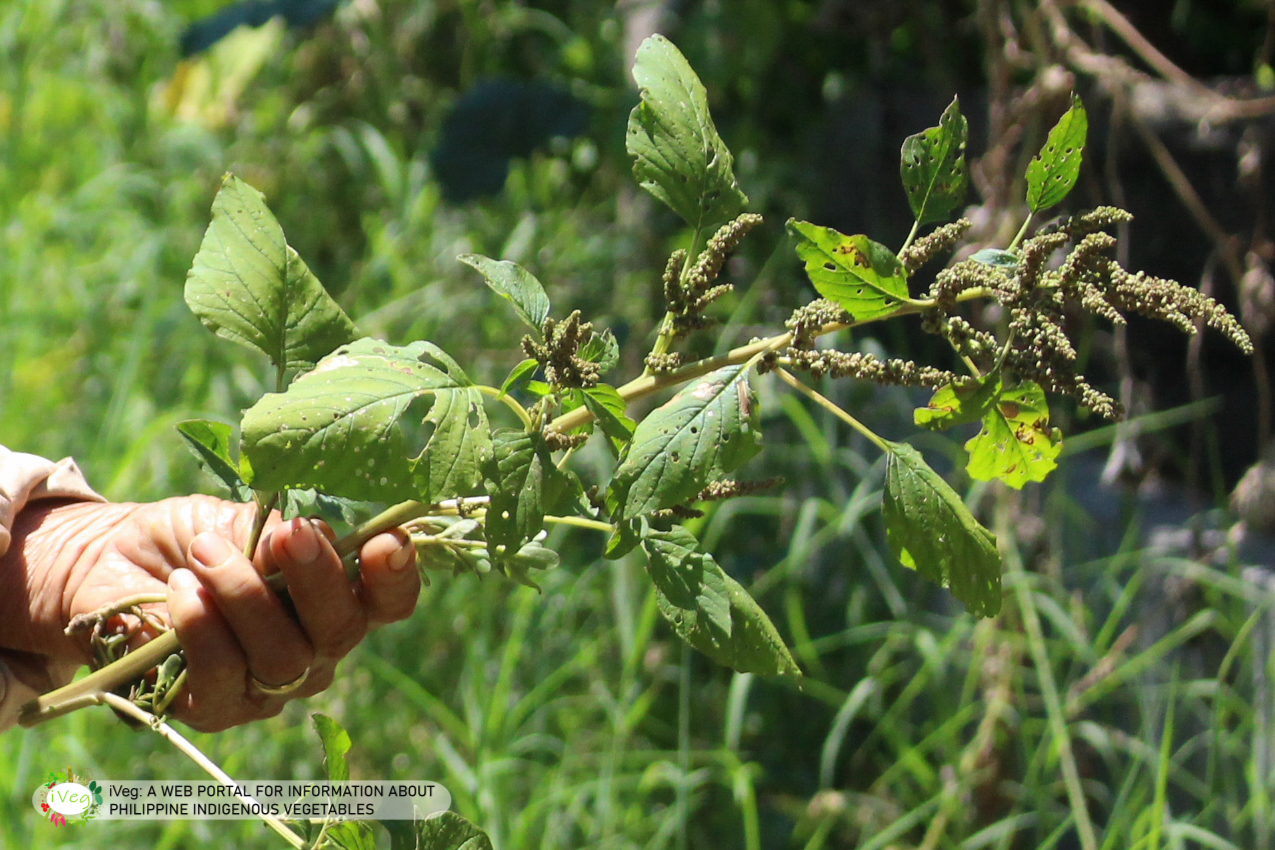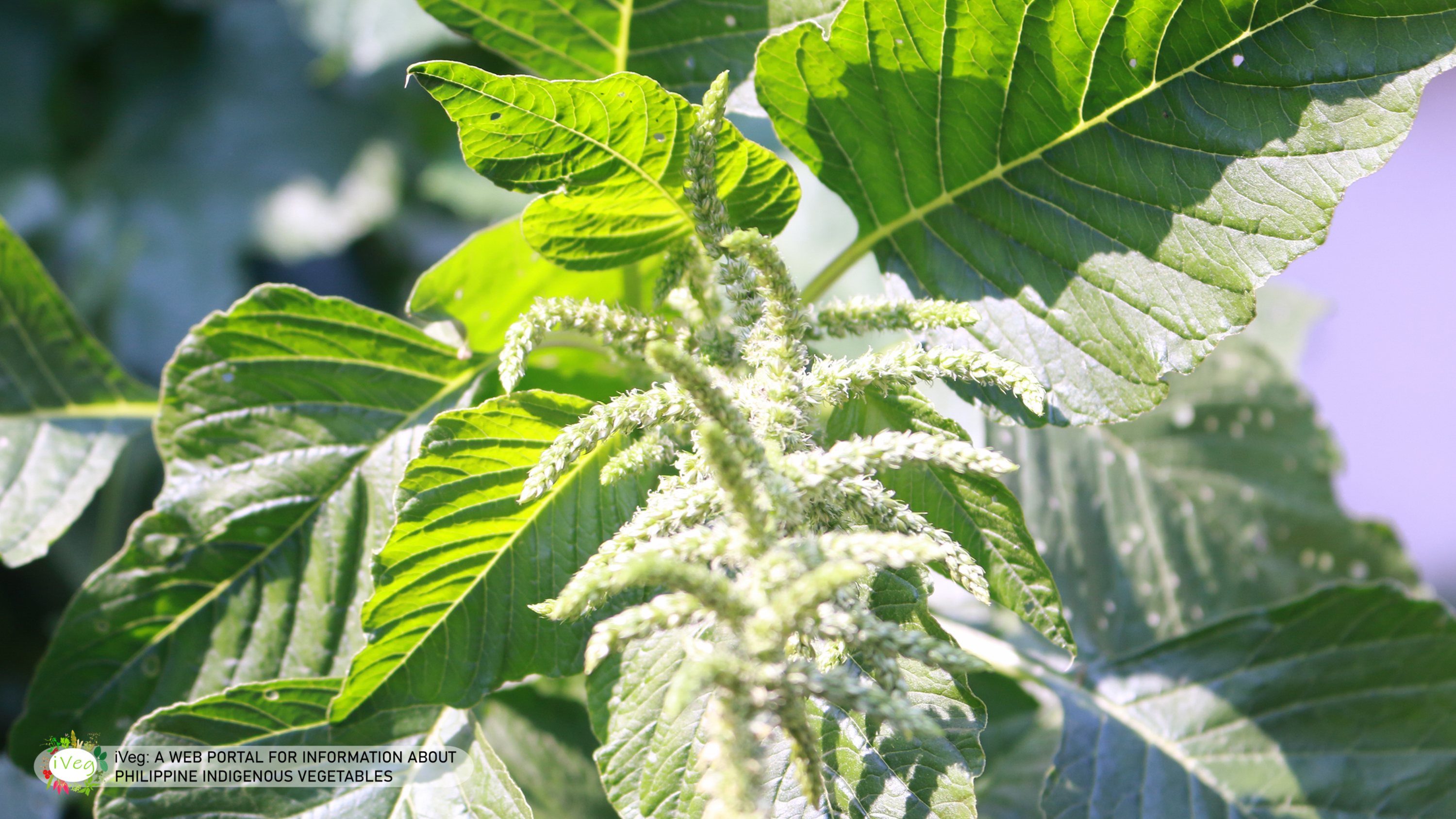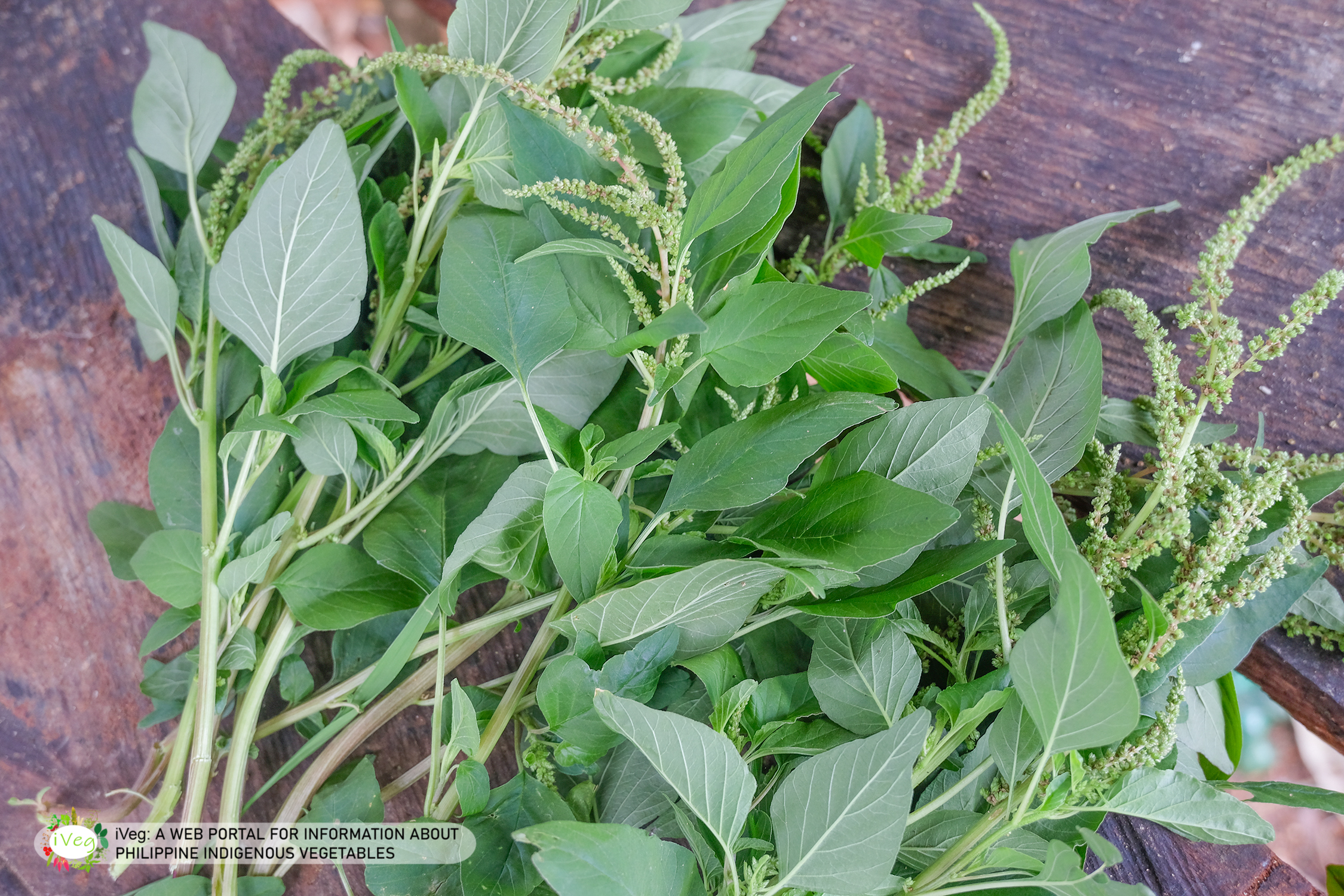Kolitis
Amaranthus viridis L.
Family:
Amaranthaceae
Synonyms:
Amaranthus viridis
Philippine local names:
Bauan (Bon.), Halom (Tag., Bis.), Halunapa (Sul.) Kadiapa (Mag.), Kalunai (Ilk.), Kilitis (Bik.), Kolitis (Tag.), Kulitis (Tag.), Nasi (It.), Siitan (Ilk.), Sitan (Ib.)
English Name: Amaranth
Botanical Description
Botany
Kolitis is an erect, smooth, branched unarmed herb, 30 to 60 centimeters high. Leaves are alternate, ovate, long-petioled, 4 to 10 centimeters long, obtuse tip, usually notched, base truncate or decurrent. Flowers are very small, densely disposed, green, 1 millimeter long. Sepals are 5, or 1 to 3, ovate to linear, often aristate. Inflorescences are terminal, axillary, simple or panicled, interrupted spikes. Fruits are compressed, indehiscent or circumcised utricles. Seeds are black or brown, orbicular.
Note: This herb differs from Amaranthus spinosus (Uray) in the absence of spines on the stems.
=http://www.stuartxchange.org/Kolitis.html
An annual herbaceous plant. Stem erect or usually ascending, 6-80 (sometimes up to 100) cm tall, glabrous to pubescent, pubescent especially upwards. Leaves glabrous or pubescent on the veins of the lower surface; petioles long (up to 10 cm), occasionally longer than the blade; blade ovate to rhombic-oblong, 2-7 x 1.5-5.5 cm, base tapered to blunt, tip rounded, minutely mucronate, barely to clearly emarginate. Flowers green, unisexual, male and female intermixed, in slender axillary to terminal paniculate spikes 2-12 cm long and 2-5 mm wide, or in dense axillary clusters in the lower part of the stem. Bracts deltoid- to lanceolate-ovate, membraneous with a short awn from the green midrib. Perianth-segments 3, about 1.5 mm long. Stigmas 2-3. Capsule nearly globose 1.25-1.75 mm long, not rupturing or rupturing irregularly, surface rough. Seed 1-1.25 mm, round, slightly compressed, dark brown to black with a paler thick border. =https://www.cabi.org/isc/datasheet/4654
Kolitis is an erect, smooth, branched unarmed herb, 30 to 60 centimeters high. Leaves are alternate, ovate, long-petioled, 4 to 10 centimeters long, obtuse tip, usually notched, base truncate or decurrent. Flowers are very small, densely disposed, green, 1 millimeter long. Sepals are 5, or 1 to 3, ovate to linear, often aristate. Inflorescences are terminal, axillary, simple or panicled, interrupted spikes. Fruits are compressed, indehiscent or circumcised utricles. Seeds are black or brown, orbicular.
Note: This herb differs from Amaranthus spinosus (Uray) in the absence of spines on the stems.
=http://www.stuartxchange.org/Kolitis.html
An annual herbaceous plant. Stem erect or usually ascending, 6-80 (sometimes up to 100) cm tall, glabrous to pubescent, pubescent especially upwards. Leaves glabrous or pubescent on the veins of the lower surface; petioles long (up to 10 cm), occasionally longer than the blade; blade ovate to rhombic-oblong, 2-7 x 1.5-5.5 cm, base tapered to blunt, tip rounded, minutely mucronate, barely to clearly emarginate. Flowers green, unisexual, male and female intermixed, in slender axillary to terminal paniculate spikes 2-12 cm long and 2-5 mm wide, or in dense axillary clusters in the lower part of the stem. Bracts deltoid- to lanceolate-ovate, membraneous with a short awn from the green midrib. Perianth-segments 3, about 1.5 mm long. Stigmas 2-3. Capsule nearly globose 1.25-1.75 mm long, not rupturing or rupturing irregularly, surface rough. Seed 1-1.25 mm, round, slightly compressed, dark brown to black with a paler thick border. =https://www.cabi.org/isc/datasheet/4654
Agroclimatic/Edaphic adaption/Ecology
A. viridis is an annual herb which grows from 6 to 100 cm high. It propagates by seed and flowers all year in subtropical and tropical climates. The seeds lose viability over time and this loss in viability is faster at higher temperatures (Purwanto and Poerba, 1990). However, treatment of seeds with concentrated sulphuric acid increased germination by three times, and 100% germination was obtained at 35°C (Ikenaga et al., 1975a). The time when seeds are sown affects germination; germination percentage increases and emergence time decreases with later sowing dates. Plants flowered with sowing in any month (Ikenaga et al., 1976a, b). High soil moisture (85%) delays seed germination. Flooding during the period between October and April kills the seeds (Yamamoto and Ohba, 1977). There was no change in the germination of seeds which were buried 2.5 cm below the surface and deeper for up to a year, indicating a survival technique used by this species (Horng and Leu, 1978).
A. viridis has C4 photosynthesis (Rajagopalan et al., 1993) and has been found to grow best in intermediate light intensities (Simbolon and Sutamo, 1986). It can co-exist with the equally common Amaranthus spinosus because the two species have different nutritional requirements (Ramakrishnan, 1976).
The basic chromosome number is 10 (Sammour et al., 1993). A. viridis hybridizes with A. blitum (Coons, 1981). Separate from hybridization, distinct forms of A. viridis have been discussed (Narwal, 1972), but not formalized due to the gradual progression of characteristics among the forms.
viridis is grown and utilized in many areas of the world as both a wild and cultivated pot herb (Uphof, 1968). The plant is rich in calcium and iron and is a good source of vitamins B and C (Morton, 1981). Due to its small seed size and use as a pot herb, A. viridis is moved, both on purpose and unwittingly, throughout the world. The seeds can survive in the digestive tract of chickens (Rodriguez et al., 1983). It is good cattle fodder, and is used medicinally and for making soap (Dalziel, 1937), but is poisonous to pigs (Salles et al., 1991).
A. viridis has C4 photosynthesis (Rajagopalan et al., 1993) and has been found to grow best in intermediate light intensities (Simbolon and Sutamo, 1986). It can co-exist with the equally common Amaranthus spinosus because the two species have different nutritional requirements (Ramakrishnan, 1976).
The basic chromosome number is 10 (Sammour et al., 1993). A. viridis hybridizes with A. blitum (Coons, 1981). Separate from hybridization, distinct forms of A. viridis have been discussed (Narwal, 1972), but not formalized due to the gradual progression of characteristics among the forms.
viridis is grown and utilized in many areas of the world as both a wild and cultivated pot herb (Uphof, 1968). The plant is rich in calcium and iron and is a good source of vitamins B and C (Morton, 1981). Due to its small seed size and use as a pot herb, A. viridis is moved, both on purpose and unwittingly, throughout the world. The seeds can survive in the digestive tract of chickens (Rodriguez et al., 1983). It is good cattle fodder, and is used medicinally and for making soap (Dalziel, 1937), but is poisonous to pigs (Salles et al., 1991).
Geographical Distribution
- A common roadside weed on lowlands at low and medium altitudes.
- Probably introduced.
- Probably originated from America.
- Found in all warm countries.
=http://www.stuartxchange.org/Kolitis.html
A. viridis is cosmopolitan in all warm regions of the world. It is one of the most common weeds in the tropics, subtropics and warm temperate regions. It is listed in virtually all of the warm temperate and tropical floras of the world.
A. viridis has also been recorded from the former USSR (Vasil'chenko, 1936).
A. viridis is found in virtually all disturbed habitats. It grows in heavy organic to very sandy soils, including muck soils after the water has gone down for the season.
=
- Probably introduced.
- Probably originated from America.
- Found in all warm countries.
=http://www.stuartxchange.org/Kolitis.html
A. viridis is cosmopolitan in all warm regions of the world. It is one of the most common weeds in the tropics, subtropics and warm temperate regions. It is listed in virtually all of the warm temperate and tropical floras of the world.
A. viridis has also been recorded from the former USSR (Vasil'chenko, 1936).
A. viridis is found in virtually all disturbed habitats. It grows in heavy organic to very sandy soils, including muck soils after the water has gone down for the season.
=
Agronomy Production Systems
Amaranthus viridis L., known in the Philippines as Spinach Tagalog and Kolitis, is sold in the market as vegetable. It is reported to exhibit antiviral and anticancer properties [1] and antinociceptive activity [2]. Another study reported that after treatment with A. viridis methanol extract, normal and streptozotocin induced diabetic rats exhibited a significant increase in body weight and a decrease in blood glucose, total cholesterol, and serum triglycerides [3]. A recent study reported that methanol extracts of A. viridis showed considerable antimicrobial activity against selected bacterial and fungal strains with MIC ranging from 179–645 g/mL. The seed extracts exhibited superior antioxidant and antimicrobial activity [4]. Earlier studies reported the isolation of quercetin and lutein [5] and rutin and ?-carotene [6] from A. viridis. Another study reported the isolation of amasterol, an ecdysone precursor and a growth inhibitor, from the roots of A. viridis [7]. We report herein the isolation of squalene (1) from the stems and leaves; spinasterol (2) from the stems and roots; and trilinolein (3), polyprenol (4), and phytol (5) from the leaves of A. viridis L. To the best of our knowledge, this is the first report on the isolation of these compounds from the plant.
Propagation
Amaranthus Viridis:
The inhibitory effect C.C.C. and the stimulatory effect o f GAS can be
shown form the mean and table and histograms Germination increased with the
increase o f concentration o f GA^ and decreased with the increase e f concentration
o f C C.C. and with the progress o f tim e.
IN THE WINTER (AT LIGHT):
The highest percentage o f germination was 80% at 500ppm o f GA3 and
lOOppm C.C.C. and the lowest percentage o f germination was 54% at lOOppm GA^
and lOOppm o f C.C.C. The promotary effect GA^ can be prevented by the inhibitory
effect o f C.C C ; so at 250ppm o f GA£ and 500ppm o f C.C.C. the germination
percentage was 57% against the germination percentage o f 83% at 250ppm o f GA
alone m THE WINTER (AT DARK):
The highest percentage of germination was 89% at 500ppm of GA3 and
500ppm of C.C.C and lowest percentage of germination gradually was 30% at
500ppm of C.C.C and lOOppm of C.C.C against 22% control The germination
gradually increased up to 7 days .
IN THE SUMMER (AT LIGHT ):
The highest percentage of germination was 65% at 500ppm of GA3 and
lOOppm of C/.C.C. and the lowest percentage of germination was 45.5% with lOOppm
of C C.C. and 500ppm of GA3 against 24% in control.
IN THE SUMMER (AT DARK):
The highest percentage of germination was 39% AT 500 ppm of C.C.C
lowest percentage of germination was 24% at 100 ppm of ga and 500 ppm of C.C C
against 12% in control.
Page 193-194
=http://shodhganga.inflibnet.ac.in/bitstream/10603/66738/10/10_summary.pdf
The inhibitory effect C.C.C. and the stimulatory effect o f GAS can be
shown form the mean and table and histograms Germination increased with the
increase o f concentration o f GA^ and decreased with the increase e f concentration
o f C C.C. and with the progress o f tim e.
IN THE WINTER (AT LIGHT):
The highest percentage o f germination was 80% at 500ppm o f GA3 and
lOOppm C.C.C. and the lowest percentage o f germination was 54% at lOOppm GA^
and lOOppm o f C.C.C. The promotary effect GA^ can be prevented by the inhibitory
effect o f C.C C ; so at 250ppm o f GA£ and 500ppm o f C.C.C. the germination
percentage was 57% against the germination percentage o f 83% at 250ppm o f GA
alone m THE WINTER (AT DARK):
The highest percentage of germination was 89% at 500ppm of GA3 and
500ppm of C.C.C and lowest percentage of germination gradually was 30% at
500ppm of C.C.C and lOOppm of C.C.C against 22% control The germination
gradually increased up to 7 days .
IN THE SUMMER (AT LIGHT ):
The highest percentage of germination was 65% at 500ppm of GA3 and
lOOppm of C/.C.C. and the lowest percentage of germination was 45.5% with lOOppm
of C C.C. and 500ppm of GA3 against 24% in control.
IN THE SUMMER (AT DARK):
The highest percentage of germination was 39% AT 500 ppm of C.C.C
lowest percentage of germination was 24% at 100 ppm of ga and 500 ppm of C.C C
against 12% in control.
Page 193-194
=http://shodhganga.inflibnet.ac.in/bitstream/10603/66738/10/10_summary.pdf
Part utilized as vegetables
Shoots
Uses
Food/ Edibility/ Culinary
Edibility / Nutritional
- Leaves and seeds are edible.
- Eaten as vegetable.
- The tops are rich in calcium and iron. The plant is a good source of vitamins B and C.
- Study found it to be an excellent source of protein.
=http://www.stuartxchange.org/Kolitis.htmlCrop Improvement
Hand Weeding
The application of herbicides, followed by hand weeding one or two times, effectively controls A. viridis in various crops in India. Hand removal of A. viridis is an effective means of control, depending on the availability of effective herbicides.Medicinal
green vegetables supply roughages, which are necessary for cleaning the digestive system. This green vegetable supply, m
green, protein, fat, carbohydrate, and minerals.
=http://shodhganga.inflibnet.ac.in/bitstream/10603/66738/10/10_summary.pdfSocio-cultural importance
As is apparent, A. viridis is readily controlled by most standard herbicides active on broad-leaved species, but it should be noted that after repeated herbicide use, some Amaranthus species have developed herbicide-resistant strains, and the possibility of this occurring in A. viridis should be borne in mind.Others
Folkloric
- The therapeutic properties and dosage are very nearly identical to Amaranthus spinosus.
(Uray)
- Philippine Negritos apply bruised leaves directly to eczema, psoriasis and rashes.
- Poultice of leaves for inflammations, boils and abscesses.
- Use for acne and for skin cleansing.
- Infusion of plant has been used as a diuretic and galactagogue.
- Used for snake bites and scorpion stings.
- Decoction of plant used for dysentery and inflammation.
- In Ayurveda, used for treatment of diabetes. Roots known for its antifertility activity.
- In India, stem used as antidote for snake bites. Leaves used for scorpion stings. Traditionally used for constipation, inflammation, eczema, bronchitis, anemia and leprosy.
- In Nepal, infusion of powdered seeds of flower used for stomach problems. Seeds also used in pregnant women to lessen labor pains.
- In Pakistan, powder of dried seeds of A. viridis, dried fruit of Ficus carica and sugar is taken orally with water to treat eye vision problems. (37)
=http://www.stuartxchange.org/Kolitis.html
Biological Control
The potential for biological control of A. viridis has been investigated (Baloch et al., 1976; Napompeth, 1982). A. viridis may be a suitable candidate for biological control, based on the number of natural enemies of the plant. It can be controlled, or exhibit reduced growth, in the presence of secondary plant compounds of other crops and weeds. However, A. viridis may itself be allelopathic.
Correct Citation
Documentation of Indigenous Vegetables (2020) Retrieved from www.iveg.com.
See references:
https://www.cabi.org/isc/datasheet/4654https://www.researchgate.net/publication/264037457_Chemical_Constituents_of_Amaranthus_viridis/download
http://shodhganga.inflibnet.ac.in/bitstream/10603/66738/10/10_summary.pdf
http://www.stuartxchange.org/Kolitis.html




